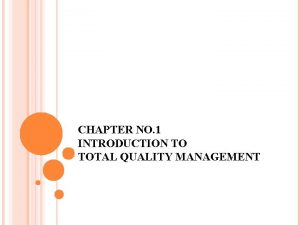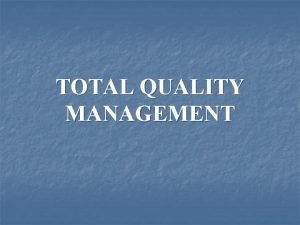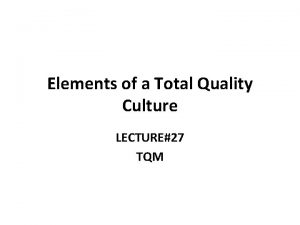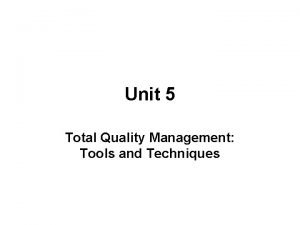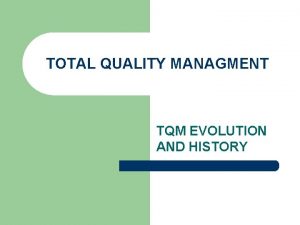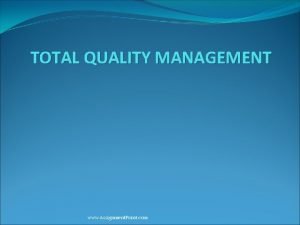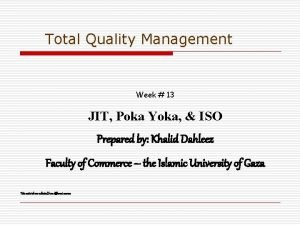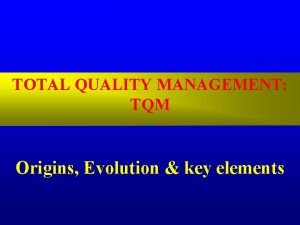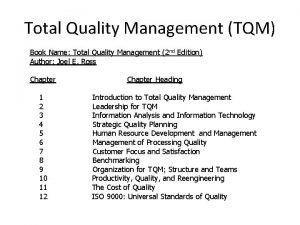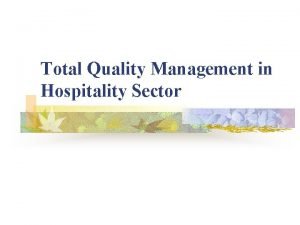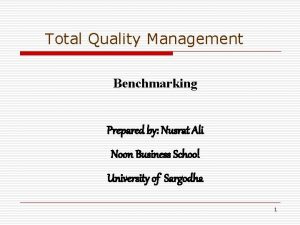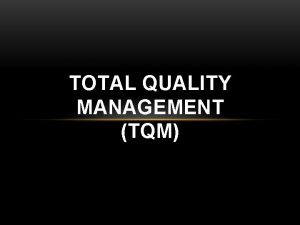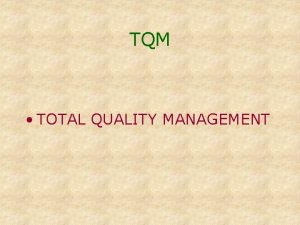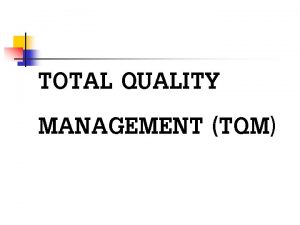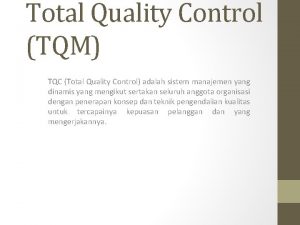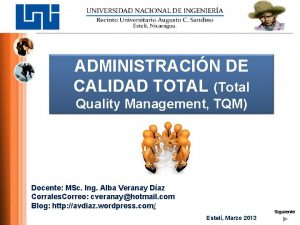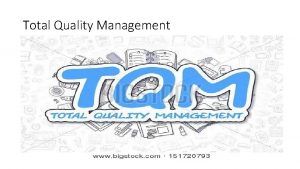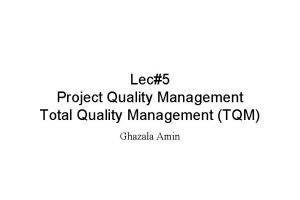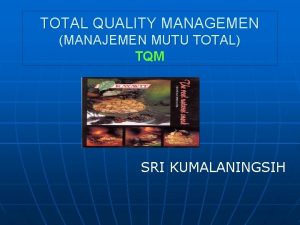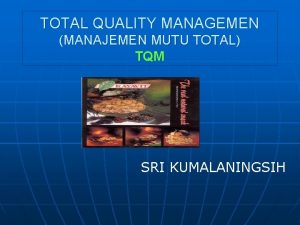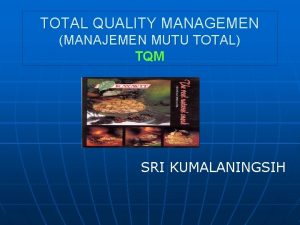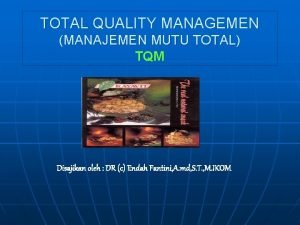Unit VI Total Quality Management TQM Introduction Quality
















- Slides: 16

Unit –VI Total Quality Management TQM: Introduction, Quality Function Deployment (QFD), 5 S, Kaizen, Poka yoke, Kanban, JIT, FMECA, Zero defects, TPM. Six Sigma: DMAIC - Concept and Applications. Quality Management System Need for quality management system – design of quality management system - quality management system requirements – ISO 9001, TS-16949, ISO 14000, Quality Audit.

TQM: Introduction • A core definition of total quality management (TQM) describes a management approach to long–term success through customer satisfaction. In a TQM effort, all members of an organization participate in improving processes, products, services, and the culture in which they work.

The eight principles are: • • 1 Customer focus. . 2 Leadership. . 3 Involvement of people. . 4 Process approach. . 5 System approach to management. . 6 Continuous improvement. . 7 Factual approach to decision making. . 8 Mutually beneficial supplier relationships.

an organization must embrace five principles 1. 2. 3. 4. 5. Produce quality work the first time. Focus on the customer. Have a strategic approach to improvement. Improve continuously. Encourage mutual respect and teamwork.

Basic Concepts of TQM • • Continuous Improvement of Quality: . . . Central Focus on the Customer: . . . Systematic Improvement of Operations: . . . Open Work Environments: . . . Long- Term Thinking: . . . Development of Human Resources: . . . Management Responsibility for TQM Leadership:

The eight pillars of TPM are mostly focused on proactive and preventive techniques for improving equipment reliability: 1. 2. 3. 4. 5. 6. 7. 8. Autonomous Maintenance. Focused Improvement. Planned Maintenance. Quality management. Early/equipment management. Education and Training. Safety Health Environment. Administrative & office TPM.


TPM : - 8 Pillers

• Piller - 2 JISHU HOZEN ( Autonomous maintenance ) : • This pillar is geared towards developing operators to be able to take care of small maintenance tasks, thus freeing up the skilled maintenance people to spend time on more value added activity and technical repairs. The operators are responsible for upkeep of their equipment to prevent it from deteriorating.

• PILLAR 3 - KAIZEN : • "Kai" means change, and "Zen" means good ( for the better ). Basically kaizen is for small improvements, but carried out on a continual basis and involve all people in the organization. Kaizen is opposite to big spectacular innovations. Kaizen requires no or little investment. The principle behind is that "a very large number of small improvements are move effective in an organizational environment than a few improvements of large value. This pillar is aimed at reducing losses in the workplace that affect our efficiencies. By using a detailed and thorough procedure we eliminate losses in a systematic method using various Kaizen tools. These activities are not limited to production areas and can be implemented in administrative areas as well. • PILLAR 4 - PLANNED MAINTENANCE : • It is aimed to have trouble free machines and equipments producing defect free products for total customer satisfaction. This breaks maintenance down into 4 "families" or groups which was defined earlier. • Preventive Maintenance • Breakdown Maintenance • Corrective Maintenance • Maintenance Prevention • With Planned Maintenance we evolve our efforts from a reactive to a proactive method and use trained maintenance staff to help train the operators to better maintain their equipment.

• PILLAR 5 - QUALITY MAINTENANCE : • It is aimed towards customer delight through highest quality through defect free manufacturing. Focus is on eliminating non-conformances in a systematic manner, much like Focused Improvement. We gain understanding of what parts of the equipment affect product quality and begin to eliminate current quality concerns, then move to potential quality concerns. Transition is from reactive to proactive (Quality Control to Quality Assurance). • QM activities is to set equipment conditions that preclude quality defects, based on the basic concept of maintaining perfect equipment to maintain perfect quality of products. The condition are checked and measure in time series to very that measure values are within standard values to prevent defects. The transition of measured values is watched to predict possibilities of defects occurring and to take counter measures before hand. • PILLAR 6 - TRAINING : • It is aimed to have multi-skilled revitalized employees whose morale is high and who has eager to come to work and perform all required functions effectively and independently. Education is given to operators to upgrade their skill. It is not sufficient know only "Know-How" by they should also learn "Know-why". By experience they gain, "Know-How" to overcome a problem what to be done. This they do without knowing the root cause of the problem and why they are doing so. Hence it become necessary to train them on knowing "Know-why". The employees should be trained to achieve the four phases of skill. The goal is to create a factory full of experts. The different phase of skills are • Phase 1 : Do not know. Phase 2 : Know theory but cannot do.

• PILLAR 7 - OFFICE TPM : • q q q Office TPM includes analyzing processes and procedures towards increased office automation to improve productivity, efficiency in the administrative functions and identify and eliminate losses: Processing loss Cost loss including in areas such as procurement, accounts, marketing, sales leading to high inventories Communication loss Idle loss Set-up loss Accuracy loss Office equipment breakdown Communication channel breakdown, telephone and fax lines Time spent on retrieval of information Non availability of correct on line stock status Customer complaints due to logistics Expenses on emergency dispatches/purchases • PILLAR 8 - SAFETY, HEALTH AND ENVIRONMENT: • • • In this area focus is on to create a safe workplace and a surrounding area that is not damaged by process or procedures. and targets zero accident, zero health damage and zero fires by creating awareness among employees various competitions like safety slogans, Quiz, Drama, Posters, etc. related to safety can be organized at regular intervals.


TPM & TQM

5 S

 Total quality management founder
Total quality management founder Total quality management introduction
Total quality management introduction Introduction of tqm
Introduction of tqm Contemporary management practices
Contemporary management practices What is tqm
What is tqm Management gurus and their contributions
Management gurus and their contributions Quality culture in tqm
Quality culture in tqm Tools and techniques of quality management
Tools and techniques of quality management What is total quality managment
What is total quality managment Tqm definition
Tqm definition Poka yoka
Poka yoka Tqm summary
Tqm summary Deming chain reaction
Deming chain reaction Total quality management book
Total quality management book Total quality management in hospitality industry
Total quality management in hospitality industry Benchmarking in total quality management
Benchmarking in total quality management Quality assurance model in nursing
Quality assurance model in nursing

